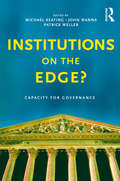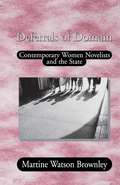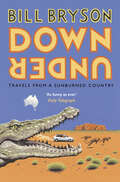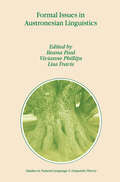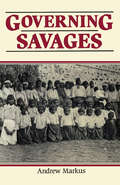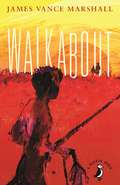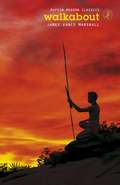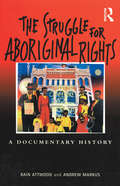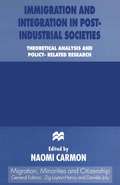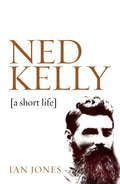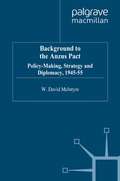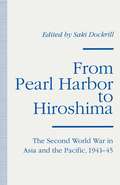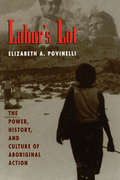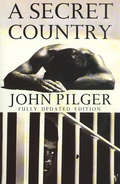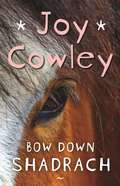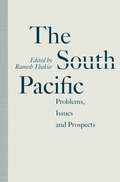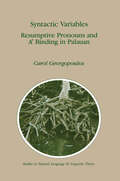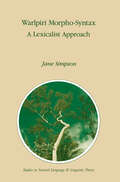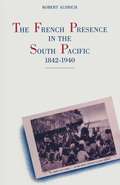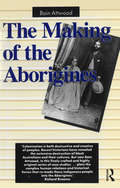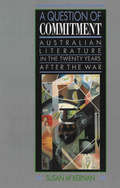- Table View
- List View
Institutions on the edge?: Capacity for governance
by Michael Keating John Wanna Patrick WellerAustralia faces major challenges to its forms of governance. Changing expectations from its citizens, global pressures on the economy and technological innovation are impacting on government operations. Yet most of its institutions were designed a hundred years ago. Cabinet government was inherited. Parliament was already established in its forms and procedures. The federal structure, the High Court and the federal public service were created as a consequence. The party structure has been effectively frozen since the 1920s and a tradition of handing some responsibilities to arms-length organisations was well established.So how have these institutions changed over the last hundred years and how well will they adapt to the demands of the modern world? Do they have the capacity to adapt appropriately and enable governments to achieve their preferred outcomes? In this book experienced academics and practitioners explore these questions. They examine each of the institutions in terms of their ability to meet new challenges and provide some hope that Australia's institutions, even if at times slow to move and dominated by internal interests, have a capacity to adapt and govern effectively. The book shows our political institutions in a new light, as dynamic, often flexible organisms; it provides important new insights into the way we are governed and how our system of governance might develop in the future.
Institutions on the edge?: Capacity for governance
by Michael Keating John Wanna Patrick WellerAustralia faces major challenges to its forms of governance. Changing expectations from its citizens, global pressures on the economy and technological innovation are impacting on government operations. Yet most of its institutions were designed a hundred years ago. Cabinet government was inherited. Parliament was already established in its forms and procedures. The federal structure, the High Court and the federal public service were created as a consequence. The party structure has been effectively frozen since the 1920s and a tradition of handing some responsibilities to arms-length organisations was well established.So how have these institutions changed over the last hundred years and how well will they adapt to the demands of the modern world? Do they have the capacity to adapt appropriately and enable governments to achieve their preferred outcomes? In this book experienced academics and practitioners explore these questions. They examine each of the institutions in terms of their ability to meet new challenges and provide some hope that Australia's institutions, even if at times slow to move and dominated by internal interests, have a capacity to adapt and govern effectively. The book shows our political institutions in a new light, as dynamic, often flexible organisms; it provides important new insights into the way we are governed and how our system of governance might develop in the future.
Deferrals of Domain: Contemporary Women Novelists and the State
by NA NAContemporary female novelists tend to portray the relationship between women and the state as profoundly negative, in contrast to various constructions in current feminist theory. Martine Watson Brownley analyzes novels by Margaret Atwood, Paule Marshall, Nadine Gordimer, and Margaret Drabble to explore the significance of this disparity. The book uses literary analysis to highlight elements of state power that many feminist theorists currently occlude, ranging from women's still minimal access to state politics to the terrifying violence exercised by modern states. At the same time, however, feminist theory clarifies major elements in many contemporary women's lives about which the novels are ambivalent or misleading, such as romantic love and the role of sexuality in state politics. Deferrals of Domain fills a double gap, both authorial and topical, in current critical treatments of women writers and will be of interest to both literary and women's studies scholars.
Down Under: Travels in a Sunburned Country (Bryson #6)
by Bill BrysonIt is the driest, flattest, hottest, most desiccated, infertile and climatically aggressive of all the inhabited continents and still Australia teems with life – a large portion of it quite deadly. In fact, Australia has more things that can kill you in a very nasty way than anywhere else.Ignoring such dangers – and yet curiously obsessed by them – Bill Bryson journeyed to Australia and promptly fell in love with the country. And who can blame him? The people are cheerful, extrovert, quick-witted and unfailingly obliging: their cities are safe and clean and nearly always built on water; the food is excellent; the beer is cold and the sun nearly always shines. Life doesn’t get much better than this…
Formal Issues in Austronesian Linguistics (Studies in Natural Language and Linguistic Theory #49)
by I. Paul V. Phillips Lisa TravisAustronesian languages have long raised interesting questions for generative theories of syntax and morphology. The papers in this volume encompass some of these traditional questions and place them in newer theoretical contexts. Some of the papers also address new issues which add to our understanding of members of this language family on one side and the nature of linguistic theories on the other. There are three broad issues that re-occur throughout the volume - the role and analysis of verbal morphology, the nature of the subject or the topic in these languages, and the interaction of syntax and specificity. The papers in this volume show that as formal theories become more precise, a wider range of language data can be captured, and as the inventory of language data grows, the accuracy of formal linguistic theories improves.
Governing Savages: Commonwealth And Aboriginies, 1911-39
by Andrew MarkusIn 1928, after a white man was killed, a punitive party mounted a series of attacks on Aborigines northwest of Alice Springs. The party's leader admitted that 31 Aborigines were killed. One missionary in the area put the toll at 70; another at as many as 100.Since 1911, the administration of the Northern Territory had been the direct responsibility of the Commonwealth. In placing this event and others within the context of policies pursued by the national government, Governing Savages reveals how policies of brutality and calculated neglect bequeathed a bitter legacy to subsequent generations.
Governing Savages
by Andrew MarkusIn 1928, after a white man was killed, a punitive party mounted a series of attacks on Aborigines northwest of Alice Springs. The party's leader admitted that 31 Aborigines were killed. One missionary in the area put the toll at 70; another at as many as 100.Since 1911, the administration of the Northern Territory had been the direct responsibility of the Commonwealth. In placing this event and others within the context of policies pursued by the national government, Governing Savages reveals how policies of brutality and calculated neglect bequeathed a bitter legacy to subsequent generations.
Walkabout (Penguin Joint Venture Readers Ser.)
by James Vance MarshallMary and her young brother Peter are the only survivors of an aircrash in the middle of the Australian outback. Facing death from exhaustion and starvation, they meet an aboriginal boy who helps them to survive, and guides them along their long journey. But a terrible misunderstanding results in a tragedy that neither Mary nor Peter will ever forget . . .
Walkabout (Penguin Joint Venture Readers Ser.)
by James Vance MarshallMary and her young brother Peter are the only survivors of an aircrash in the middle of the Australian desert. Facing death from exhaustion and starvation, they meet an aboriginal boy who helps them to survive, and guides them along their long journey. But a terrible misunderstanding results in a tragedy that neither Mary nor Peter will ever forget...
The Struggle for Aboriginal Rights: A documentary history
by Bain Attwood Andrew MarkusThe Struggle for Aboriginal Rights is the first book of its kind. Not only does it tell the history of the political struggle for Aboriginal rights in all parts of Australia; it does so almost entirely through a selection of historical documents created by the Aboriginal campaigners themselves, many of which have never been published. It presents Aboriginal perspectives of their dispossession and their long and continuing fight to overcome this. In charting the story of Aboriginal political activity from its beginnings on Flinders Island in the 1830s to the fight over native title today, this book aims to help Australians better understand both the continuities and the changes in Aboriginal politics over the last 150 years: in the leadership of the Aboriginal political struggle, the objectives of these campaigners for rights for Aborigines, their aspirations, the sources of their programmes for change, their methods of protest, and the outcomes of their protest. Through the words of Aboriginal activists, across 150 years, The Struggle for Aboriginal Rights charts the relationship between political involvement and Aboriginal identity.
The Struggle for Aboriginal Rights: A documentary history
The Struggle for Aboriginal Rights is the first book of its kind. Not only does it tell the history of the political struggle for Aboriginal rights in all parts of Australia; it does so almost entirely through a selection of historical documents created by the Aboriginal campaigners themselves, many of which have never been published. It presents Aboriginal perspectives of their dispossession and their long and continuing fight to overcome this. In charting the story of Aboriginal political activity from its beginnings on Flinders Island in the 1830s to the fight over native title today, this book aims to help Australians better understand both the continuities and the changes in Aboriginal politics over the last 150 years: in the leadership of the Aboriginal political struggle, the objectives of these campaigners for rights for Aborigines, their aspirations, the sources of their programmes for change, their methods of protest, and the outcomes of their protest. Through the words of Aboriginal activists, across 150 years, The Struggle for Aboriginal Rights charts the relationship between political involvement and Aboriginal identity.
Immigration and Integration in Post-Industrial Societies: Theoretical Analysis and Policy-Related Research (Migration, Diasporas and Citizenship)
by Naomi CarmonNaomi Carmon has brought together a group of distinguished scholars from post-industrial countries to discuss changes in immigration flows, their impact on the receiving countries, and alternative policy responses. Experts in sociology, economics, political science, geography and urban planning base their analyses on evidence from USA, Australia, Britain, France and Israel. They examine past experience and analyze the present situation, in which new types of immigrants, in changing circumstances, are creating new patterns of settlement and integration.
Ned Kelly: A short life
by Ian Jones'the best Kelly biography by a country mile' - The AustralianThe definitive biography of Ned Kelly - and a superb description of his times. A bestseller since it was first published, Ned Kelly: A Short Life is acknowledged as being the definitive biography. Ian Jones combines years of research into all the records of the era and exhaustive interviews with living descendants of those involved, to present a vivid and gripping account of one of Australia's most iconic figures. ‘It will probably stand as the definitive account of Kelly’s life and its meaning…a work of prodigious scholarship, vivid reportage and sharp analysis…the most detailed portrait of the outlaw ever written’ - Rod Moran, West Australian‘the definitive biographical work’ - Dr John McQuilton, author of The Kelly Outbreak
Background to the Anzus Pact: Policy-Makers, Strategy and Diplomacy, 1945-55 (Cambridge Imperial and Post-Colonial Studies)
by W. McIntyreThis book contains a detailed analysis of American, British, Australian and New Zealand strategic planning during the early years of the Cold War, including their plans for fighting World War III in the Middle East, and the diplomatic negotiations leading up to the security treaty signed by Australia, New Zealand and the United States in 1951. It considers the problems raised by Britain's exclusion from Anzus and the subsequent creation of Seato and the British Commonwealth Far East Strategic Reserve in Malaya.
From Pearl Harbor to Hiroshima: The Second World War in Asia and the Pacific, 1941–45
by Saki Dockrill'The most significant issue that Dockrill addresses is that of how Japan views the war in retrospect, a question which not only tells us a lot about how events were seen in Japan in 1941 but is also, a matter still of importance in contemporary East Asian politics.' Antony Best, London School of Economics This multi-authored work, edited by Saki Dockrill, is an original, unique, and controversial interpretation of the Second World War in Asia and the Pacific. Dr Dockrill, the author of Britain's Policy for West German Rearmament, has skilfully converted the proceedings of an international conference held in London into a stimulating and readable account of the Pacific War. This is a valuable contribution to our knowledge of the subject.
Labor's Lot: The Power, History, and Culture of Aboriginal Action
by Elizabeth A. PovinelliHow does an Aboriginal community see itself, its work, and its place on the land? Elizabeth Povinelli goes to the Belyuen community of northern Australia to show how it draws from deep connections between labor, language, and the landscape. Her findings challenge Western notions of "productive labor" and longstanding ideas about the role of culture in subsistence economies. In Labor's Lot, Povinelli shows how everyday activities shape Aboriginal identity and provide cultural meaning. She focuses on the Belyuen women's interactions with the countryside and on Belyuen conflicts with the Australian government over control of local land. Her analysis raises serious questions about the validity of Western theories about labor and culture and their impact on Aboriginal society. Povinelli's focus on women's activities provides an important counterpoint to recent works centering on male roles in hunter-gatherer societies. Her unique "cultural economy" approach overcomes the dichotomy between the two standard approaches to these studies. Labor's Lot will engage anyone interested in indigenous peoples or in the relationship between culture and economy in contemporary social practice.
A Secret Country
by John PilgerExpatriate journalist and film-maker John Pilger writes about his homeland with life-long affection and a passionately critical eye. In this fully updated edition of A Secret Country, he pays tribute to a little known Australia and tells a story of high political drama.
Bow Down Shadrach
by Joy Cowley** Winner of the New Zealand Children's Book of the Year 1990** A classic junior fiction favourite from multi-award winning New Zealand children's author, Joy Cowley.Shadrach is a very old circus-trained Clydesdale horse, and the favourite family pet. When Hannah discovers that Shadrach has been sold to a dog food factory, she decides to mount a heroic rescue and enlists the help of her two younger brothers. From the beginning their plans go seriously wrong. By the time they've argued with the repulsive Wuff Stuff man, hidden Shadrach in a church and a caravan, and floated him on a mussel barge they're in desperate need of rescuing themselves.
The South Pacific: Problems, Issues and Prospects
by Ramesh ThakurPolitical, security, economic and ecological issues in the South Pacific have acquired increasing regional and international prominence. In The South Pacific observers from within and outside the region describe and analyse the dynamics of the region, assessing the problems, issues and prospects of the area.
Syntactic Variables: Resumptive Pronouns and A′ Binding in Palauan (Studies in Natural Language and Linguistic Theory #24)
by C. GeorgopoulosThis book represents the culmination of an extended period of field work on the Palauan language, carried out while I was a graduate student at the University of California at San Diego. The book was born as a short term paper written in 1982; from a forgettable infancy, that paper grew and grew, reaching the age of majority in my dissertation at the end of 1985. Some of its offspring have gone off on their own, as indepen dent papers, as course materials, or as thoughts that have not yet com pletely materialized. Some have been disowned. The full adulthood of this study of Palauan is realized in the present book. Virtually every section of the dissertation has been rewritten, updated, or otherwise (I hope) improved. Where the dissertation was still struggling with various problems, the book has found solutions. The aim of the book remains, however, to give broad coverage of Palauan, with emphasis on A' binding, rather than to focus narrowly on a few highly specific theoretical issues. I hope to have achieved a balance between presenting the language clearly and nonprejudicially, and deal ing with various of its properties in current theoretical terms. If I have, the book should prove to be a resource for further typological study of the phenomena it describes.
Warlpiri Morpho-Syntax: A Lexicalist Approach (Studies in Natural Language and Linguistic Theory #23)
by J. SimpsonThe French Presence in the South Pacific, 1842–1940
by Robert AldrichAn examination of France's presence in the South Pacific after the takeover of Tahiti. It places the South Pacific in the context of overall French expansion and current theories of colonialism and imperialism and evaluates the French impact on Oceania.
The Making of the Aborigines
by Bain AttwoodBefore 1788, the peoples of this continent did not consider themselves 'Aboriginal'. They only became 'Aborigines' in the wake of the British invasion. In this startling and original study, Bain Attwood reveals how relationships between black Australians and European colonisers determined the hearts and minds of the indigenous peoples, making them anew as Aboriginals.In examining the period after the 'killing times', this young historian provides new perspectives on racial ideology, government policy, and the rule of law. In examining European domination, he unravels the patterns of associations which were woven between European and Aborigine, and shows the complex meanings and significance these relationships held for both groups.In this book, the dispossessed are not cast as merely passive victims; they appear as real characters, men and women who adapted to European colonisation in accordance with their own historical and cultural experience. Out of this exchange the colonised created a new consciousness and began to forge a common identity for themselves.A story of cultural change and continuity both poignant and disturbing in its telling, this important book is sure to provoke controversy about what it means to be Aboriginal.'This intelligent and impeccably researched book seeks to advance our understanding of the story of white/Aboriginal contact. It will be required reading for anyone working in the field.' - Henry Reynolds'Colonisation is both destructive and creative of peoples. Recent historians have revealed the extensive destruction of black Australians and their cultures. But now Bain Attwood, in this finely crafted and highly original series of case studies. plots the complex human relations and historical forces that re-made these indigenous people into the Aborigines.' - Richard Broome
The Making of the Aborigines
by Bain AttwoodBefore 1788, the peoples of this continent did not consider themselves 'Aboriginal'. They only became 'Aborigines' in the wake of the British invasion. In this startling and original study, Bain Attwood reveals how relationships between black Australians and European colonisers determined the hearts and minds of the indigenous peoples, making them anew as Aboriginals.In examining the period after the 'killing times', this young historian provides new perspectives on racial ideology, government policy, and the rule of law. In examining European domination, he unravels the patterns of associations which were woven between European and Aborigine, and shows the complex meanings and significance these relationships held for both groups.In this book, the dispossessed are not cast as merely passive victims; they appear as real characters, men and women who adapted to European colonisation in accordance with their own historical and cultural experience. Out of this exchange the colonised created a new consciousness and began to forge a common identity for themselves.A story of cultural change and continuity both poignant and disturbing in its telling, this important book is sure to provoke controversy about what it means to be Aboriginal.'This intelligent and impeccably researched book seeks to advance our understanding of the story of white/Aboriginal contact. It will be required reading for anyone working in the field.' - Henry Reynolds'Colonisation is both destructive and creative of peoples. Recent historians have revealed the extensive destruction of black Australians and their cultures. But now Bain Attwood, in this finely crafted and highly original series of case studies. plots the complex human relations and historical forces that re-made these indigenous people into the Aborigines.' - Richard Broome
A Question of Commitment: Australian literature in the twenty years after the war
by Susan LeverIn the years since the Second World War, Australia has seen a period of literary creativity which outshines any earlier period in the nation's literary history. This creativity has its beginnings in the arguments and alignments which emerged at the end of the War, and the changes in perceptions of art and society which occurred during the fifties and early sixties.A Question of Commitment examines the attitudes of writers as diverse as James McAuley, Frank Hardy, Judith Wright, Patrick White and A. D. Hope, as they responded to a changing Australian society during the postwar years. Through their work and that of many others, it considers the debates about literary nationalism, the artistic politics of the Cold War, the threat of technology to art in the Atomic Age, and the nature of the writer's role in the new society. It documents the way in which the political commitments of some writers and the resistance to commitment of others were challenged by political and social changes of the late fifties.Susan McKernan's lively exploration of Australia's writers in a time of innovation provides the reader with the context needed to understand the creative choices they made and, in so doing, introduces wider intellectual and cultural issues which remain relevant to this day.
